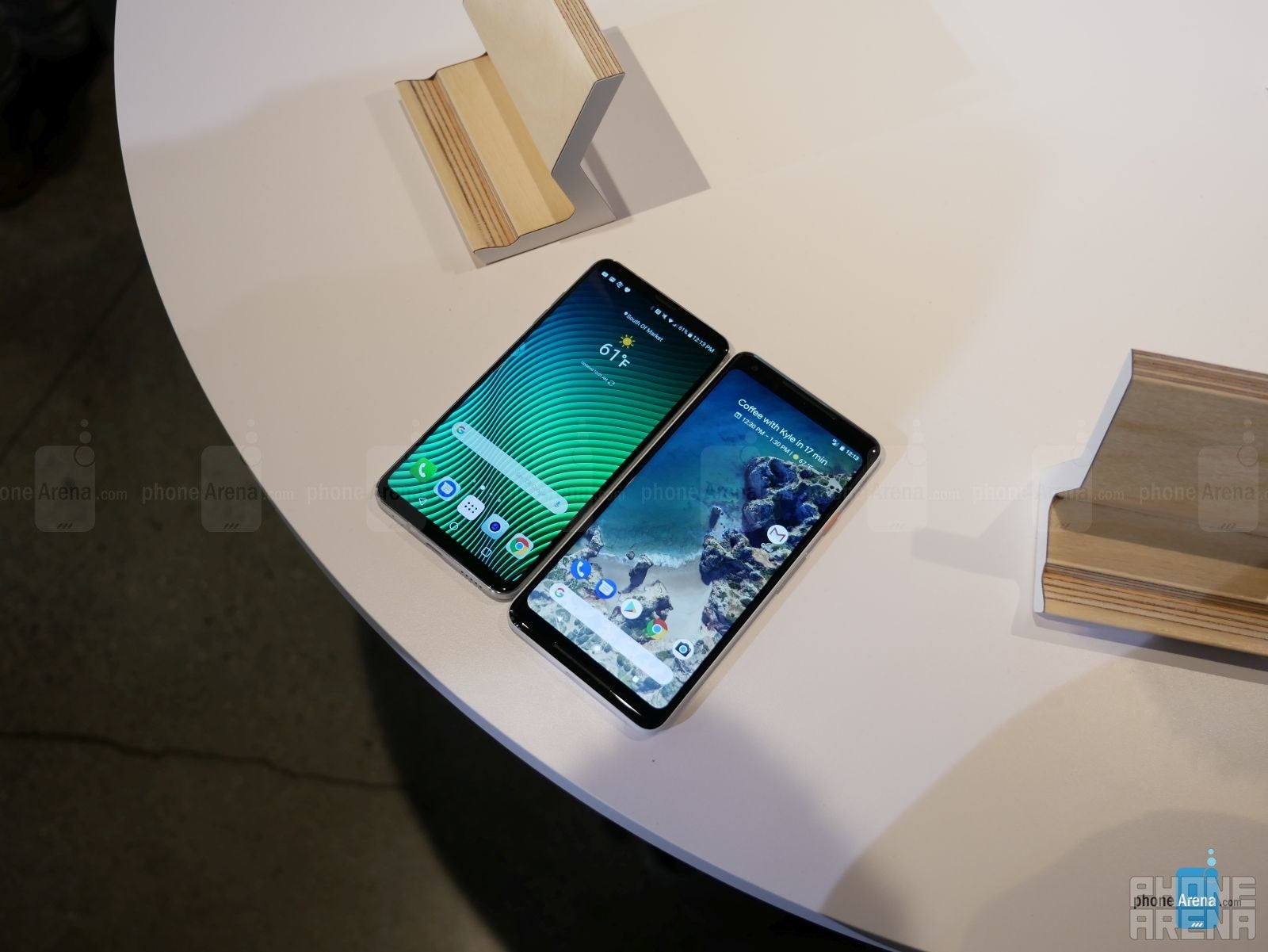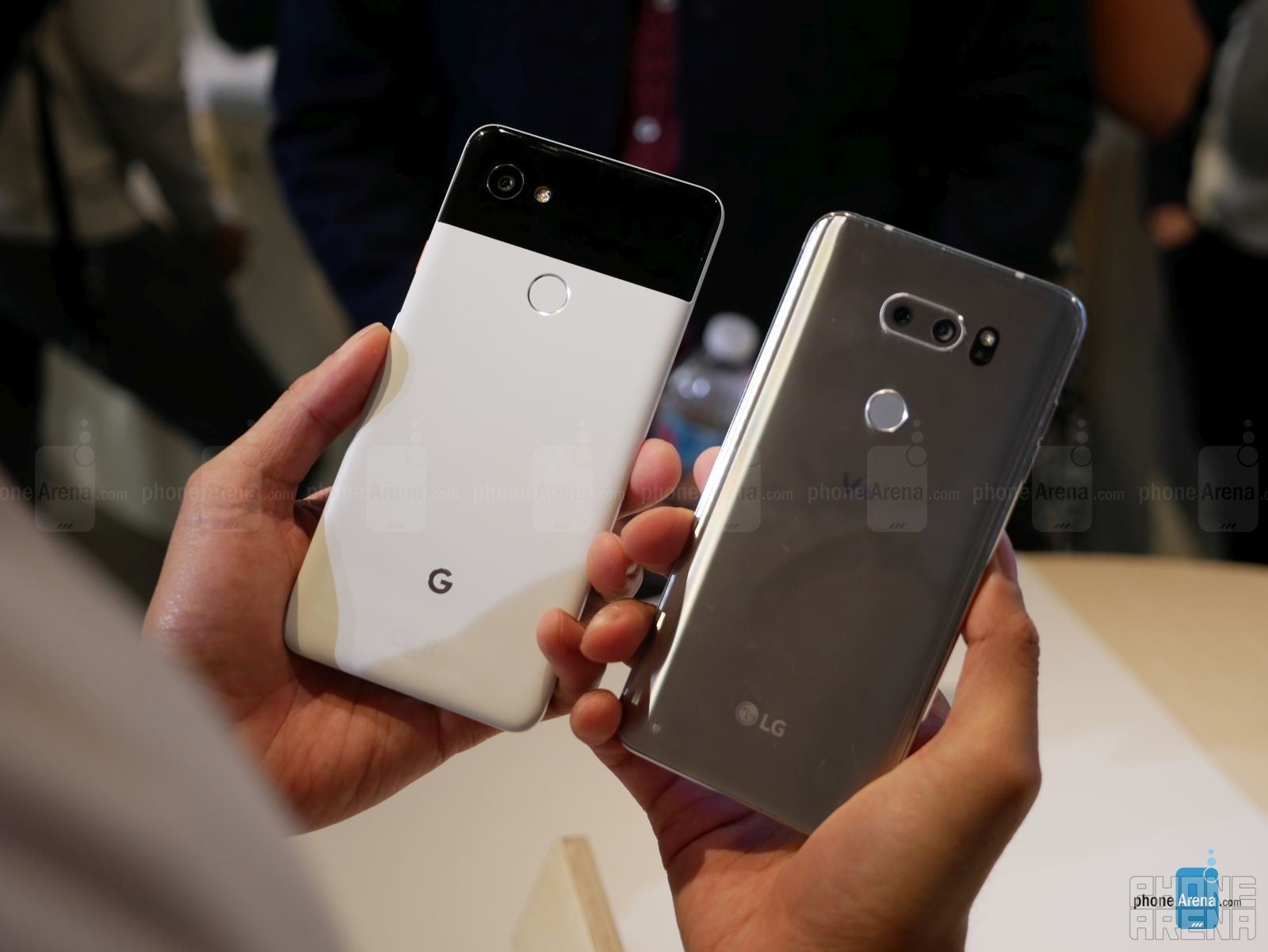Google Pixel 2 XL vs LG V30: first look

With the introduction of the Pixel 2 XL, Google gave the duty of manufacturing the phone to LG – a departure from last year's choice with HTC. The switch is pretty significant, especially now that the LG V30 has been making considerable waves since first being introduced at IFA 2017 not too long ago. Needless to say, these two smartphones are going to draw comparisons, since we're dealing with phones that stack up nicely against one another.
From the front, these two closely match each other to the tooth with their breezeless designs and sloping edges. Honestly, it's tough to really tell them apart! Flip them around, however, that's when we begin to see the difference. While the two share a metal meets glass construction, the Pixel 2 XL doesn't feel as fragile as the V30 – due to the all-glass surface of the V30. Then again, the V30 looks and feels more premium because the so-called metal surface of the Pixel 2 XL feels rather plastic in texture.
For the Google Pixel 2 XL, we're glad to see that it features dual front-firing speakers, which are far more suitable than just the single one in the V30. That one has a tendency of being covered by accident, resulting in muffled tones when watching video. Despite that, the V30 puts the Pixel 2 XL to shame because it's able to incorporate a 3.5mm headphone jack into its svelte body. If the V30 can do this, why couldn't the Pixel 2 XL follow suit? Who knows, but it's a convenience that we appreciate with the V30.
The resemblance between these two titans is evident once again when we pay attention to their displays. From their size, to their aspect ratios, and display technology, it's a splitting image between them. That's a 6-inch 2880 x 1440 POLED display with an aspect ratio of 18:9, so the specs are identical from the looks of it. We were astounded by the V30's display, so it’s no shock that we share the same sentiments here with the Pixel 2 XL. Both are gorgeous, making it really tough to prefer one over the other until we get more intimate time with the two phones together.
Design
From the front, these two closely match each other to the tooth with their breezeless designs and sloping edges. Honestly, it's tough to really tell them apart! Flip them around, however, that's when we begin to see the difference. While the two share a metal meets glass construction, the Pixel 2 XL doesn't feel as fragile as the V30 – due to the all-glass surface of the V30. Then again, the V30 looks and feels more premium because the so-called metal surface of the Pixel 2 XL feels rather plastic in texture.
Display
The resemblance between these two titans is evident once again when we pay attention to their displays. From their size, to their aspect ratios, and display technology, it's a splitting image between them. That's a 6-inch 2880 x 1440 POLED display with an aspect ratio of 18:9, so the specs are identical from the looks of it. We were astounded by the V30's display, so it’s no shock that we share the same sentiments here with the Pixel 2 XL. Both are gorgeous, making it really tough to prefer one over the other until we get more intimate time with the two phones together.

User Interface
This certainly an area of contention, mainly because it's almost impossible to dislike the stock Android experience. Being a Pixel and all, the Pixel 2 XL benefits from a vanilla Android 8.0 experience from the get-go – while also being treated to some additional software features that places more emphasis on the power of Google Assistant. From its new "at a glance" widget on the homescreen that keeps you up-to-date with reminders, to the enhancements made to Google Lens, and even the novel feature of squeezing the phone to initiate Google Assistant, there's a lot going for the Pixel 2 XL that you won't find in the V30.
Don't get us wrong, the LG V30's software experience is still more than functional, but given that we're dealing with a Pixel phone here, the V30 might not be able to keep up with feverish rate that the Pixel 2 XL will see with software updates.
Processor and Memory
Well, it's no shock that they come packing the same kind of heat under the hood. Leverage the Qualcomm Snapdragon 835 SoC coupled with 4GB of RAM, they both exhibit the same level of responsiveness from the get-go. Who knows what it'll be like after months and years of continuous use, but chances are the Pixel 2 XL won't shed any of its zip. That may potentially can be the same with the V30, but only time will tell.
Sadly, though, there's no storage expansion of any kind with the Pixel 2 XL – so you're stuck with either its 64GB or 128GB capacities. Even though the storage options are the same for the V30, it benefits greatly from having a microSD card slot for expansion.
Camera
Now this is an interesting area to look at, just because on one hand, we have a phone that offers extensive manual controls, while the other aims for performance and simplicity. The LG V30 is undoubtedly going to attract content creators thanks to its dual-cameras – a 16MP main sensor and a wide-angle 13MP one. Add to that the cool LG Cine modes it offers, as well as true manual video controls, the V30 has a versatile camera system in place for would-be filmmakers.
In contrast, the Google Pixel 2 XL forgoes the dual-camera implementation, opting instead to stick with just a single 12MP rear camera. Some might be concerned by this, but given how the Pixel XL managed to exceed expectations with its impressive photo capturing qualities, there shouldn't be any cause for alarm here. In fact, it’s able to even pull off an impressive portrait mode of sorts by software-based learning to produce that bokeh effect to background elements.

Battery
Over in the battery department, the Google Pixel 2 XL has a slight advantage on paper with its 3520 mAh battery cell – in comparison to the V30's 3300 mAh capacity. It's not a huge difference, but it'll be interesting to see whether or not that equates to significant longevity for the Pixel 2 XL. It's worth nothing, however, that the LG V30 with its metal meets glass construction offers the convenience of wireless charging – whereas that's not even an option for the Pixel 2 XL.
Expectations
Diving into the pricing of these two top-tiered smartphones, the LG V30 seems to have the advantage as it's slapped with a starting price of about $800 in US, which is less than the $850 asking price for the Pixel 2 XL. Indeed, there are pros and cons found between the two phones, but there's one thing we can all gladly agree about – LG is a winner regardless of the outcome. From a software standpoint, the Pixel 2 XL gets the nods from us, which it should given that stock Android is always preferred. However, the LG V30 is an incredibly features rich phone with a stunning design to match.









Things that are NOT allowed: